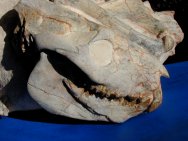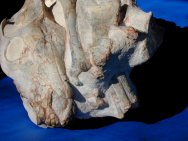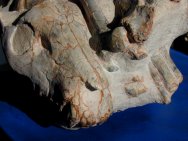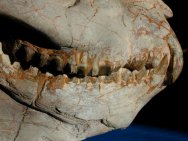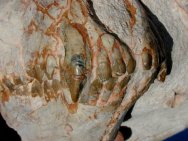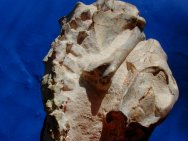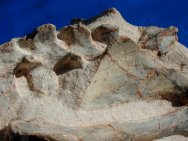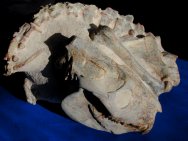 Description:
The badlands of the western US are particularly rich in mammal fossils
from the late Eocene to Miocene. The Brule Formation is exposed
over a huge area including Nebraska, North and South Dakota, Wyoming,
and Colorado, and yields abundant fossils as layers are eroded.
This diverse group of stocky prehistoric mammals grazed amid the
grasslands, prairies or savannas of North and Central America throughout
much of the Cenozoic era. In many ways, Oreodonta is an icon of
Oligocene North America. Description:
The badlands of the western US are particularly rich in mammal fossils
from the late Eocene to Miocene. The Brule Formation is exposed
over a huge area including Nebraska, North and South Dakota, Wyoming,
and Colorado, and yields abundant fossils as layers are eroded.
This diverse group of stocky prehistoric mammals grazed amid the
grasslands, prairies or savannas of North and Central America throughout
much of the Cenozoic era. In many ways, Oreodonta is an icon of
Oligocene North America.
Merycoidodon
was an oreodont, (meaning "mountain tooth") and were hoofed
herbivorous (plant-eating) mammals. Merycoidodon was a  quadrupedal
ruminant closely related to camels, pigs, and sheep. The skull was
elongated and the upper canines were chisel shaped; the cheek teeth
were used for grinding. It could reach a length of 4.5 ft long.
It was a member of the Artiodactyla (even-toed ungulates). Suborder
Tylopoda (padded feet - oreodonts, camels), Family Merycoidodontidae,
Genus Merycoidodon, the type species is Merycoidodon culbertsonii
(Leidy, 1848). quadrupedal
ruminant closely related to camels, pigs, and sheep. The skull was
elongated and the upper canines were chisel shaped; the cheek teeth
were used for grinding. It could reach a length of 4.5 ft long.
It was a member of the Artiodactyla (even-toed ungulates). Suborder
Tylopoda (padded feet - oreodonts, camels), Family Merycoidodontidae,
Genus Merycoidodon, the type species is Merycoidodon culbertsonii
(Leidy, 1848).
 We
will never know the story of this oreodont’s final time before
passing, to eventually be fossilized in the Brule formation. But,
curled in the fetal position, there is a certain placid and compelling
nature to this fossil. Was it caught in the open with no cover in
an ash fall event, or, in a winter blizzard? The preparator seemed
to have summed it up best with his remark that it “appears
to be kissing its butt goodbye”! This is an
excellently preserved skull and partial skeleton. It is large with
well preserved teeth and bone. Note the full vertebral column, pelvis,
various leg bones and ribs, exposed on both the front and rear sides.
It has had less than 10% restoration. We
will never know the story of this oreodont’s final time before
passing, to eventually be fossilized in the Brule formation. But,
curled in the fetal position, there is a certain placid and compelling
nature to this fossil. Was it caught in the open with no cover in
an ash fall event, or, in a winter blizzard? The preparator seemed
to have summed it up best with his remark that it “appears
to be kissing its butt goodbye”! This is an
excellently preserved skull and partial skeleton. It is large with
well preserved teeth and bone. Note the full vertebral column, pelvis,
various leg bones and ribs, exposed on both the front and rear sides.
It has had less than 10% restoration.
|



